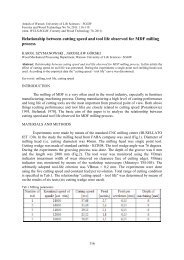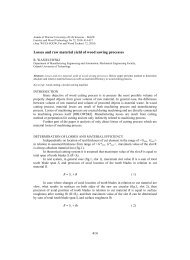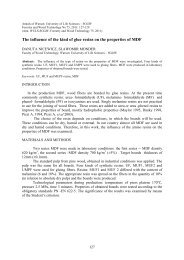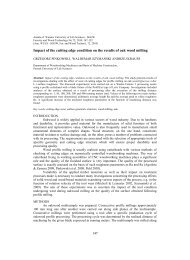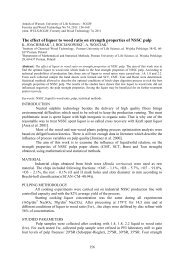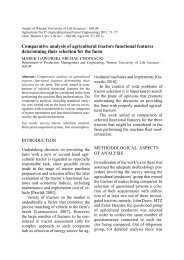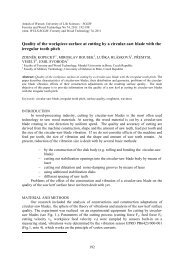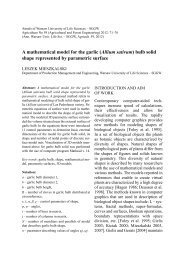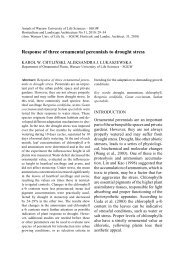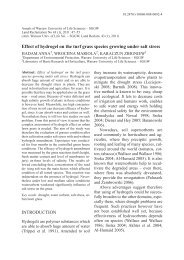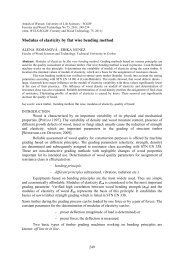Annals of Warsaw University of Life Sciences – SGGW. Animal ...
Annals of Warsaw University of Life Sciences – SGGW. Animal ...
Annals of Warsaw University of Life Sciences – SGGW. Animal ...
Create successful ePaper yourself
Turn your PDF publications into a flip-book with our unique Google optimized e-Paper software.
12 K. Fiszdon, K. Góral, J. Narojek<br />
domestic cats, and contributing factors<br />
was analyzed.<br />
MATERIAL AND METHODS<br />
Questionnaires were collected from the<br />
random group <strong>of</strong> owners <strong>of</strong> 269 cats.<br />
They were to answer several questions<br />
concerning age, origin and breed <strong>of</strong><br />
animal in question, its maintenance conditions,<br />
as well as presence <strong>of</strong> abnormal<br />
behaviors. Those included defecation/<br />
urination in places other than provided<br />
for these purposes, aggression towards<br />
other cats, other animals and humans,<br />
excessive self-grooming, autoaggressive<br />
and destructive behaviors.<br />
Group consisted <strong>of</strong> 135 toms, 91 <strong>of</strong><br />
them castrated, and 134 queens, 78 <strong>of</strong><br />
them spayed. They were attributed to<br />
three age groups: up to 2 years (57 cats),<br />
from 2 to 8 years (124) and over 8 years<br />
<strong>of</strong> age (81). In seven cases owners were<br />
unable to specify the age.<br />
The majority <strong>of</strong> cats, i.e. 209, were<br />
random bred, 43 pure bred (as numbers in<br />
any <strong>of</strong> the breeds were low, they were all<br />
classified in one group), 17 had one pure<br />
bred parent, and they were classified as<br />
Mix.<br />
143 cats were <strong>of</strong> completely unknown<br />
background and collected from streets,<br />
farms etc. (2 <strong>of</strong> them were actually<br />
adopted from animal shelters), 28 came<br />
from breeders, 15 were born and reared<br />
in owners homes, and 83 were born in<br />
homes and placed with other families.<br />
The influence <strong>of</strong> age at purchase/<br />
/adoption time (in one case it could not<br />
be determined), presence <strong>of</strong> other animals<br />
in the household, and number <strong>of</strong> family<br />
members were determine. Data were<br />
analyzed with Chi 2 test and level <strong>of</strong> correlations<br />
between specific features presented<br />
as V-Kramer coefficient.<br />
RESULTS AND DISCUSSION<br />
Abnormal behaviours were presented by<br />
197 individuals i.e. 73% <strong>of</strong> the population.<br />
This percentage is higher than reported<br />
either in Germany by Heidenberger (1997)<br />
(54.7%) or by Voith in USA (1981) (47%).<br />
The most common behaviour reported<br />
was scratching furniture and walls<br />
(Figure 1). This behaviour, although highly<br />
undesirable for owners, is, however, utterly<br />
natural, and can be easily prevented by<br />
providing special devices. The next most<br />
frequent ones were uncontrolled urina-<br />
Scratching <strong>of</strong> furniture and<br />
walls<br />
Urination/defecation in places<br />
other than provided<br />
Aggression towards other cats<br />
Aggression towards other<br />
animals<br />
Destructive behaviours<br />
Aggression towards humans<br />
Excessive self-grooming.<br />
Autoaggres sion<br />
FIGURE 1. Percentage <strong>of</strong><br />
behavioural disorders



